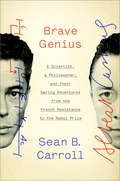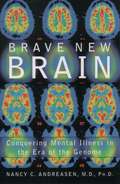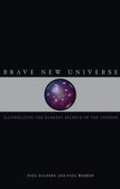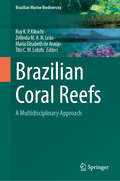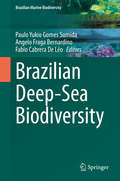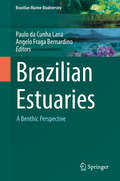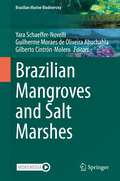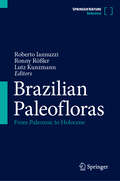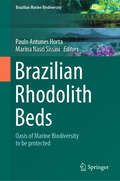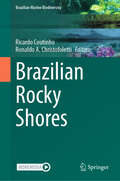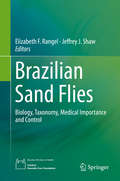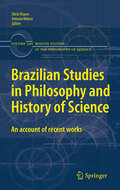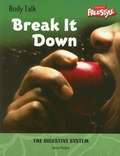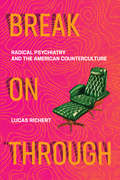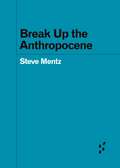- Table View
- List View
Brave Genius
by Sean B. CarrollThe never-before-told account of the intersection of some of the most insightful minds of the 20th century, and a fascinating look at how war, resistance, and friendship can catalyze genius. In the spring of 1940, the aspiring but unknown writer Albert Camus and budding scientist Jacques Monod were quietly pursuing ordinary, separate lives in Paris. After the German invasion and occupation of France, each joined the Resistance to help liberate the country from the Nazis, ascended to prominent, dangerous roles, and were very lucky to survive. After the war and through twists of circumstance, they became friends, and through their passionate determination and rare talent they emerged as leading voices of modern literature and biology, each receiving the Nobel Prize in their respective fields. Drawing upon a wealth of previously unpublished and unknown material gathered over several years of research, Brave Genius tells the story of how each man endured the most terrible episode of the twentieth century and then blossomed into extraordinarily creative and engaged individuals. It is a story of the transformation of ordinary lives into exceptional lives by extraordinary events--of courage in the face of overwhelming adversity, the flowering of creative genius, deep friendship, and of profound concern for and insight into the human condition.
Brave New Arctic: The Untold Story of the Melting North (Science Essentials)
by Mark C. SerrezeAn insider account of how researchers unraveled the mystery of the thawing ArcticIn the 1990s, researchers in the Arctic noticed that floating summer sea ice had begun receding. This was accompanied by shifts in ocean circulation and unexpected changes in weather patterns throughout the world. The Arctic's perennially frozen ground, known as permafrost, was warming, and treeless tundra was being overtaken by shrubs. What was going on? Brave New Arctic is Mark Serreze's riveting firsthand account of how scientists from around the globe came together to find answers.In a sweeping tale of discovery spanning three decades, Serreze describes how puzzlement turned to concern and astonishment as researchers came to understand that the Arctic of old was quickly disappearing--with potentially devastating implications for the entire planet. Serreze is a world-renowned Arctic geographer and climatologist who has conducted fieldwork on ice caps, glaciers, sea ice, and tundra in the Canadian and Alaskan Arctic. In this must-read book, he blends invaluable insights from his own career with those of other pioneering scientists who, together, ushered in an exciting new age of Arctic exploration. Along the way, he accessibly describes the cutting-edge science that led to the alarming conclusion that the Arctic is rapidly thawing due to climate change, that humans are to blame, and that the global consequences are immense.A gripping scientific adventure story, Brave New Arctic shows how the Arctic's extraordinary transformation serves as a harbinger of things to come if we fail to meet the challenge posed by a warming Earth.
Brave New Brain: Conquering Mental Illness in the Era of the Genome
by Nancy C. AndreasenHere, leading neuroscientist Nancy Andreasen offers a state-of-the-art look at what we know about the human brain and the human genome--and shows how these two vast branches of knowledge are coming together in a boldly ambitious effort to conquer mental illness. Andreasen gives us an engaging and readable description of how it all works---from billions of neurons, to the tiny thalamus, to the moral monitor in our prefrontal cortex. She shows the progress made in mapping the human genome, whose 30,000 to 40,000 genes are almost all active in the brain. Weread gripping stories of the people who develop mental illness, the friends and relatives who share their suffering, the physicians who treat them, and the scientists who study them so that better treatments can be found. Four major disorders are covered--schizophrenia, manic depression, anxietydisorders, and dementia--revealing what causes them and how they affect the mind and brain. Finally, the book shows how the powerful tools of genetics and neuroscience will be combined during the next decades to build healthier brains and minds. By revealing how combining genome mapping with brain mapping can unlock the mysteries of mental illness, Andreasen offers a remarkably fresh perspective on these devastating diseases.
Brave New Girl
by Rachel Vincent“Thrilling and dangerous, with an ending that will leave you gasping!” —SUZANNE YOUNG, New York Times bestselling author of the series THE PROGRAMIn a world where everyone is the same, one girl is the unthinkable: unique. A high-stakes fast-paced series launch from New York Times bestselling author Rachel Vincent. We have brown hair. Brown eyes. Fair skin. We are healthy and strong and smart. But only one of us has ever had a secret. Dahlia 16 sees her face in every crowd. She’s nothing special—just one of five thousand girls created from a single genome to work for the greater good of the city. Meeting Trigger 17 changes everything. He thinks she’s interesting. Beautiful. Unique. Which means he must be flawed. When Dahlia can’t stop thinking about him—when she can’t resist looking for him, even though that means breaking the rules—she realizes she’s flawed, too. But if she’s flawed, then so are all her identicals. And any genome found to be flawed will be recalled. Destroyed. Getting caught with Trigger would seal not only Dahlia’s fate, but that of all five thousand girls who share her face. But what if Trigger is right? What if Dahlia is different? Suddenly the girl who always follows the rules is breaking them, one by one by one. . . . ** Praise for Rachel Vincent’s The Stars Never Rise “This high-stakes, romantic thriller had me hooked from the very first page!” —Kimberly Derting, author of the Taking trilogy “Un-put-down-able.” —Kirkus Reviews “A hugely fun and entertaining read.” —SLJ “Vincent (the Soul Screamers series) carves out an intriguing niche in the post-apocalyptic landscape . . . plenty of reasons for readers to look forward to the next installment.” —PW“The gritty world is compellingly presented . . . much to consider.” —The Bulletin “A devil of a thriller.” —Booklist
Brave New Universe: Illuminating The Darkest Secrets Of The Cosmos
by Paul Halpern Paul WessonCosmologists yearn to behold the unseen elements of our universe. And as new technologies become more powerful and precise, scientists are getting their wish—though these tools are challenging the limits of our imagination as fast as they are answering many longstanding questions. Space is one of the last great frontiers for modern man. A never-ending source of investigation and inspiration, it beckons to scientists with an irresistible siren’s call. And in this glorious age of cosmology, astronomical measurement has never been more precise. The power provided to us by extraordinary new observational mechanisms has shattered former suppositions and stimulated exciting new visions of the universe. Using modern instruments such as the Wilkinson Microwave Anisotropy Probe (WMAP), astronomers now have access to information about the age and composition of the universe. By providing greatly improved answers, high-resolution satellite data and novel telescopic techniques have transformed one of science’s most speculative fields into a triumph of meticulous and rigorous detection. Yet as the technological tools grow increasingly robust and we are able to see farther and know more, we find that we have even more questions. Could there be realms beyond ordinary space? Might time, space, and matter simply be illusions? What unique blend of cosmological factors influences life on Earth? Featuring interviews with leaders in the field as well as thought-provoking descriptions of their work, Brave New Universe is a guided tour of current advances and controversies in cosmology.
Brazilian Coral Reefs: A Multidisciplinary Approach (Brazilian Marine Biodiversity)
by Ruy K. P. Kikuchi Maria Elisabeth de Araújo Zelinda M. A. N. Leão Tito M. C. LotufoThe Brazilian coral reefs form structures significantly different from the well-known reef models, as follows: they have a growth form of mushroom-shaped coral pinnacles called "chapeirões"; they are built by a low diversity coral fauna rich in endemic species, with most of them relic forms dating back to the Miocene; and the nearshore bank reefs are surrounded by siliciclastic sediments. The reefs are distributed into four major sectors along the Brazilian coast: the northern, the northeastern, and the eastern regions, and the oceanic islands, but certain isolated coral species can be found in warmer waters in the embayment of the southern region. There are different types of bank reefs, fringing reefs, isolated "chapeirões" and an atoll present along the Brazilian coast. Corals, milleporids, and coralline algae build the rigid frame of the reefs. The areas in which the major coral reefs occur correspond to regions in which nearby urban centers are experiencing accelerated growth, and tourism development is rapidly increasing. The major human effects on the reef ecosystem are mostly associated with the increased sedimentation due to the removal of the Atlantic rainforest and the disposal of industrial and urban effluents. Fishing resources are seriously declining due to pollution and overfishing, and this reduction impacts artisanal fishers, who are impoverished and face food security risks. The effects of warming oceanic waters that have been affecting several reef areas with high-intensity coral bleaching did not show until the 2010 event, episodes of coral mass mortality in Brazilian reefs. However, since 2016, bleaching has increased, as has the mortality of milleporids. There are opportunities to develop purposeful biotechnologies that can support coral reef restoration and conservation. Reciprocally, preserved coral reef ecosystems containing peculiar genetic resources allow biotechnological opportunities to provide products and processes for economically and ecologically prosperous societies.
Brazilian Deep-Sea Biodiversity (Brazilian Marine Biodiversity)
by Angelo Fraga Bernardino Paulo Yukio Gomes Sumida Fabio Cabrera De LéoThis book presents the biodiversity of the Brazilian deep-sea and its many unique geological and biological features, as well as a review of its ecology, conservation, and future research needs. The deep-sea Brazilian margin has an incredible geological heterogeneity with numerous characteristic seafloor features, and latitudinal changes in marine productivity, oceanographic conditions and biological communities have resulted in very distinct biological assemblages at regional and bathymetric scales. It is a tremendously rich ecosystem in terms of living species, from which many well-known historical tales have originated, and with unique importance for the global climate and humanity. Nevertheless, vast areas of the Brazilian margin have been explored for fishing, oil and gas, and other commodities, likely impacting a variety of deep-sea habitats at scales and intensities yet undetermined. This book is intended for students, scholars, professionals and a wide audience interested in the deep-sea in general and, more specifically, in the South Atlantic deep-sea.
Brazilian Environmental and Climate Change Law
by Rafael Martins Costa Moreira Gabriel WedyThe book covers a range of topics including the historical evolution and present landscape of Brazilian environmental law; fundamental principles of environmental law; environmental constitutionalism in Brazil; the legal framework governing environmental assets; animal protection and rights; environmental federalism; national environmental policy; administrative tools for environmental regulation; civil and criminal environmental liability; judicial interpretations of environmental law; specially protected areas; climate change legislation and litigation; and water resource management. This book is intended for those interested in Brazilian environmental and climate change law, specifically catering to students, lawyers, jurists, scholars, and anyone eager to grasp the key aspects and current status of this field. With the international focus on Brazil as a 'continental Country' and the limited availability of English literature on the subject, compounded by the challenges many non-Portuguese speaking academics encounter, this book serves as a comprehensive resource for understanding how Brazil's legal and justice systems address environmental issues.
Brazilian Estuaries: A Benthic Perspective (Brazilian Marine Biodiversity)
by Paulo Da Lana Angelo Fraga BernardinoThis book presents the main drivers of benthic structure and processes in estuaries from the 8,000 km-Brazilian coast, assesses the influence of natural and human disturbance, and discusses their ecological importance and management needs. Estuaries are unique coastal ecosystems often with low biodiversity that sustain and provide essential ecological services to mankind. These ecosystems include a variety of habitats with their own sediment and fauna dynamics, all of them globally altered or threatened by human activities. Mangroves, saltmarshes, tidal flats and other confined estuarine systems are under increasing stress by overfishing and other human activities leading to habitat and species loss. Combined changes in estuarine hydromorphology and in climate pose severe threats to estuarine ecosystems at a global scale.
Brazilian Mangroves and Salt Marshes (Brazilian Marine Biodiversity)
by Yara Schaeffer-Novelli Guilherme Moraes de Oliveira Abuchahla Gilberto Cintrón-MoleroThis book offers a new ecosystemic approach to the understanding of mangrove and salt marsh ecosystems. Brazil has one of the largest areas of mangroves in the world, where salt marshes might or might not be associated. Different landscapes comprise the extensive coastline, where mangrove and salt marsh species’ composition is discussed through the analysis of physiography, zonation, and succession processes. Both salt marsh and mangrove plants and the associated macroalgae will be characterized in their ecophysiological and phenological aspects, as well as genetic and epigenetic diversity. The chapters on microbial diversity and litterfall expose the well-known importance of these ecosystems as highly productive carbon sinks and pumps. The associated fauna of invertebrates (benthic meio and macrofaunas, especially brachyuran crabs) and vertebrates (fishes, birds, and mammals) are presented in a special section. The conservational approach encompasses issues, such as historical ecology, economic valuation, protected areas, environmental education, climate changes, and adaptive management.
Brazilian Medicinal Plants (Natural Products Chemistry of Global Plants)
by Luzia V. Modolo Mary Ann FoglioThe vast and exciting Brazilian flora biodiversity is still underexplored. Several research groups are devoted to the study of the chemical structure richness found in the different Biomes. This volume presents a comprehensive account of the research collated on natural products produced from Brazilian medicinal plants and focuses on various aspects of the field. The authors describe the key natural products and their extracts with emphasis upon sources, an appreciation of these complex molecules and applications in science. Many of the extracts are today associated with important drugs, nutrition products, beverages, perfumes, cosmetics and pigments, and these are highlighted. Key Features: Presents Brazilian biodiversity: its flora, its people, and its research Describes the emergence of natural products research in Brazil Emphasizes the increasing global interests in botanical drugs Aids the international natural product communities to better understand the herbal resources in Brazil Discusses Brazilian legislation to work with native plants
Brazilian Paleofloras: From Paleozoic to Holocene
by Roberto Iannuzzi Ronny Rößler Lutz KunzmannThis book will cover the entire evolutionary history that the terrestrial plants have recorded in Brazilian sedimentary rocks, ranging from the first vestiges of terrestrial environments colonization about 400 million years ago, until reaching the eve of the present time, when the current vegetation formations were organizing to reach their current distribution, diversity and structure in modern biomes. At present Brazil is home to the world's greatest plant biodiversity and we aim to offer here an opportunity to appreciate how this floral biodiversity originated and developed in these lowlands of South America, through chapters elaborated by the best Brazilian paleobotanist and palynologists in collaboration with foreign experts who dedicate to elucidate the evolution of the ancient flora in this part of the planet.
Brazilian Rhodolith Beds: Oasis of Marine Biodiversity to be protected (Brazilian Marine Biodiversity)
by Paulo Antunes Horta Marina Nasri SissiniRhodolith beds form biogenic reefs, oases of high biodiversity in sedimentary seabed environments. The rhodoliths are foundation species, which provide shelter and substrata for important and abundant benthic communities. Currently they have been recognized as an important player to the carbon balance, contributing to the planetarium climatic equilibrium. In Brazil, these environments are frequent and abundant and can be major carbonate ‘factories’ with a key role in the biogeochemical cycling of carbon in the South Atlantic Ocean. However, these organisms and environments are under threat from climate change, particularly ocean acidification and global warming, as well as local stressors such as fishing impacts and coastal run-off. In our book, written by dozens of researchers from different regions and expertise, you will dive more deeply in these and many other subjects related to this wonderful and vulnerable pink and dynamic underwater ecosystems.
Brazilian Rocky Shores (Brazilian Marine Biodiversity)
by Ricardo Coutinho Ronaldo A. ChristofolettiRocky shores correspond to a very particular habitat in Brazil, which is concentrated in the Southeastern and Southern coasts. There are different types of substrata and seascapes that cause a high environmental heterogeneity responsible to host a high species biodiversity and a range of ecosystem services. Primary and secondary production, as well as structuring organisms and processes, differs from temperate areas.
Brazilian Sand Flies: Biology, Taxonomy, Medical Importance and Control
by Elizabeth F. Rangel Jeffrey J. ShawThis is the first English-language book dedicated to Brazilian sand flies and their medical importance. No other country has so many species of these haematophagous insects as Brazil and their diversity has reached an astonishing level. The book contains comprehensive chapters, written by Brazilian experts on their regional distribution, their ecology and their importance as vectors of pathogens and parasites. Methods for sampling, processing and preserving phlebotomines are reviewed as are perspectives on surveillance and leishmaniasis vector control. A novel classification is presented whose aim is to help investigators identify the species that they are working with more efficiently.
Brazilian Sandy Beaches (Brazilian Marine Biodiversity)
by Antonia Cecilia Zacagnini Amaral Helio Herminio Checon Guilherme Nascimento CorteMore than 4000 beaches distributed along the Brazilian coastline are one of the country's main assets. They harbor endemic and diverse biota and provide numerous goods and services essential to human populations. However, they are under increasing pressure, trapped between the impacts of climate change and human activities in the terrestrial and marine environment, and the knowledge about their environmental characteristics and biodiversity is still insufficient to ensure their preservation. This book is the first-ever comprehensive work about Brazil's sandy beaches addressing their physical, ecological, and social aspects. It was written by an interdisciplinary group of leading Brazilian researchers from different regions of the country and also had the contribution of a few international experts. The information synthesized in this book is accessible to anyone who wants to know more about Brazilian coastal biodiversity and represents a significant step towards conserving Brazilian sandy beaches, their biodiversity, and ecosystem services.
Brazilian Studies in Philosophy and History of Science: An account of recent works (Boston Studies in the Philosophy and History of Science #290)
by Décio Krause Antonio VideiraThis volume, The Brazilian Studies in the Philosophy and History of Science, is the first attempt to present to a general audience, works from Brazil on this subject. The included papers are original, covering a remarkable number of relevant topics of philosophy of science, logic and on the history of science. The Brazilian community has increased in the last years in quantity and in quality of the works, most of them being published in respectable international journals on the subject. The chapters of this volume are forwarded by a general introduction, which aims to sketch not only the contents of the chapters, but it is conceived as a historical and conceptual guide to the development of the field in Brazil. The introduction intends to be useful to the reader, and not only to the specialist, helping them to evaluate the increase in production of this country within the international context.
Break It Down: How Scientists Separate Mixtures
by Ashley Chase Jonathan CurleyNIMAC-sourced textbook
Break It Down: The Digestive System
by Steve ParkerTake a new look at the human body. Find out what happens to the food you eat as it makes its journey through your body. Using interesting photos and facts, this book will really make you think about your body and the amazing things that go on inside you every second. You'll never feel the same way about yourself!
Break On Through: Radical Psychiatry and the American Counterculture
by Lucas Richert“Antipsychiatry,” Esalen, psychedelics, and DSM III: Radical challenges to psychiatry and the conventional treatment of mental health in the 1970s.The upheavals of the 1960s gave way to a decade of disruptions in the 1970s, and among the rattled fixtures of American society was mainstream psychiatry. A “Radical Caucus” formed within the psychiatric profession and the “antipsychiatry” movement arose. Critics charged that the mental health establishment was complicit with the military-industrial complex, patients were released from mental institutions, and powerful antipsychotic drugs became available. Meanwhile, practitioners and patients experimented with new approaches to mental health, from primal screaming and the therapeutic use of psychedelics to a new reliance on quantification. In Break on Through, Lucas Richert investigates the radical challenges to psychiatry and to the conventional treatment of mental health that emerged in the 1970s and the lessons they offer for current debates.Drawing on archives and government documents, medical journals, and interviews, and interweaving references to pop (counter)culture into his account, Richert offers fascinating stories of the decade's radical mental health practices. He discusses anti–Vietnam War activism and the new diagnosis of post–traumatic stress disorder given to some veterans; the radical psychiatrists who fought the system (and each other); the entry of New Age–style therapies, including Esalen's Human Potential Movement, into the laissez-faire therapeutic marketplace of the 1970s; the development of DSM III; and the use of LSD, cannabis, and MDMA. Many of these issues have resonance today. Debates over medical marijuana and microdoses of psychedelics echo debates of the 1970s. With rising rates of such disorders as anxiety and depression, practitioners and patients continue to search for therapeutic breakthroughs.
Break Up the Anthropocene (Forerunners: Ideas First)
by Steve MentzTakes the singular eco-catastrophic &“Age of Man&” and redefines this epoch We live in a new world: the Anthropocene. The Age of Man is defined in many ways, and most dramatically through climate change, mass extinction, and human marks in the geological record. Ideas of the Anthropocene spill out from the geophysical sciences into the humanities, social sciences, the arts, and mainstream debates—but it&’s hard to know what the new coinage really means. Break Up the Anthropocene argues that this age should subvert imperial masculinity and industrial conquest by opening up the plural possibilities of Anthropocene debates of resilience, adaptation, and the struggle for environmental justice. Forerunners: Ideas First Short books of thought-in-process scholarship, where intense analysis, questioning, and speculation take the lead
Breakfast Of Biodiversity
by Vandana Shiva Ivette Perfecto John VandermeerThe continuing devastation of the world's tropical rain forest affects us all-spurring climate change, decimating biodiversity, and wrecking our environment's resiliency. Millions of worried people around the world want to do whatever it takes to save the forest that is left.But halting rain forest destruction means understanding what is driving it.In Breakfast of Biodiversity, John Vandermeer and Ivette Perfecto insightfully describe the ways in which such disparate factors as the international banking system, modern agricultural techniques, rain forest ecology, and the struggles of the poor interact to bring down the forest. They weave an alternative vision in which democracy, sustainable agriculture, and land security for the poor are at the center of the movement to save the tropical environment.
Breakfast with Einstein: The Exotic Physics of Everyday Objects
by Chad OrzelA Sunday Times Book of the Year From the author of the international bestseller How to Teach Quantum Physics to Your Dog Your humble alarm clock, digital cameras, the smell of coffee, the glow of a grill, fibre broadband, smoke detectors… all hold secrets about quantum physics. Beginning at sunrise, Chad Orzel reveals the extraordinary science that underpins the simplest activities we all do every day, from making toast to shopping online. It&’s all around us, the wonderful weirdness of quantum – you just have to know where to look.
Breakfast with Einstein: The Exotic Physics of Everyday Objects
by Chad OrzelYour alarm goes off, and you head to the kitchen to make yourself some toast and a cup of coffee. Little do you know, as you savor the aroma of the steam rising from your cup, that your ordinary morning routine depends on some of the weirdest phenomena ever discovered. The world of quantum physics is generally thought of as hopelessly esoteric. While classical physics gives us the laws governing why a ball rolls downhill, how a plane is able to fly, and so on, its quantum cousin gives us particles that are actually waves, "spooky" action at a distance, and Schrodinger's unlucky cat. But, believe it or not, even the most mundane of everyday activities is profoundly influenced by the abstract and exotic world of the quantum. In Breakfast with Einstein, Chad Orzel illuminates the strange phenomena lurking just beneath the surface of our ordinary lives by digging into the surprisingly complicated physics involved in his (and anyone's) morning routine. Orzel, author of How to Teach Quantum Physics to Your Dog, explores how quantum connects with everyday reality, and offers engaging, layperson-level explanations of the mind-bending ideas central to modern physics. From the sun, alarm clocks, and the red glow of a toaster's hot filaments (the glow that launched quantum mechanics) to the chemistry of food aroma, a typical day is rich with examples of quantum weirdness. Breakfast with Einstein reveals the hidden physics all around us, and after reading this book, your ordinary mornings will never seem quite as ordinary again.
Breakfast with the Centenarians: The Science of Ageing Well
by Daniela MariLearn the art of growing old from the supercentenarians living life to the fullest. It's said that life begins at 40—but that number is constantly revised upwards as we live longer and longer. With the number of centenarians having quadrupled in the last 30 years, more of us can now hope to reach the 100-year mark than ever before. But how can we navigate this journey with grace, dignity and style? In this charming and informative book, Daniela Mari, an Italian doctor caring for some of the oldest people on the planet, draws on her experiences as a renowned gerontologist to reveal the science behind a healthy, happy old age. It turns out that the world's centenarians can teach us a thing or two about ageing well. And the secrets are not always what you'd think. Informed by the latest medical studies and incredible stories of individual longevity, Mari shows how our lifestyles can far surpass the influence of our genetics and why a daily glass of liquor isn't the end of the world. From our sleeping habits and diet to the crucial importance of our passions and interests, this is the essential handbook for a fruitful and fulfilling old age.
